Did you know that there are more than twenty types of cutting boards around the globe? If you thought cutting board types were only wood and plastic, you’re wrong. By reading this guide, you’ll understand the different types of cutting boards.
Different classification procedures for cutting boards are based on factors like materials, features, functions, and many more. According to Food Safety and Inspection Service USA, non-porous cutting boards are easier to clean than wooden ones.
This article will explain each cutting board type and their respective classes. Read the article to learn a bonus tip at the end.
JUMP TO: Based on Material | Based on the Grain Pattern | Based on color | Based on shape | Based on Features and Functions |
Types of Cutting Boards by Material
The material used to make a cutting board is the most common form of its classification. You can use any material to make a cutting board as long as it’s solid and can withstand some force. Some of the most common materials used include;
Wood
Wood cutting boards have existed since the inception of cutting boards in the kitchen. However, it is still one of the most valuable pieces in the kitchen to date. Thousands of kitchen users will have a wood-cutting board in their homes.
The wood-cutting board has its popularity not only for its beauty but for its long-lasting feature. If you maintain your wooden cutting board correctly, you may not need to purchase another piece. Also, wood cutting boards are an all-rounder in the functions required by cutting boards.
Wood cutting boards are the most popular because wood, the raw material, is readily available. However, it would help if you did not clean the wood board in a dishwasher as it can damage it.
Caution: Do not wash your wood cutting board in a dishwasher, which causes warping and cracking.
Plastic
After wood cutting boards, the most common cutting board again is plastic boards. Plastic cutting boards are popular because they usually have low prices. Since everyone can afford it regardless of social class, you’ll find these cutting boards almost anywhere.
Another exciting feature of plastic cutting boards is cleaning them with a dishwasher. Unlike wood cutting boards, you can throw the plastic ones in the dishwasher to clean them, saving you time and energy. However, plastic boards are more complex to clean than their wooden counterparts.
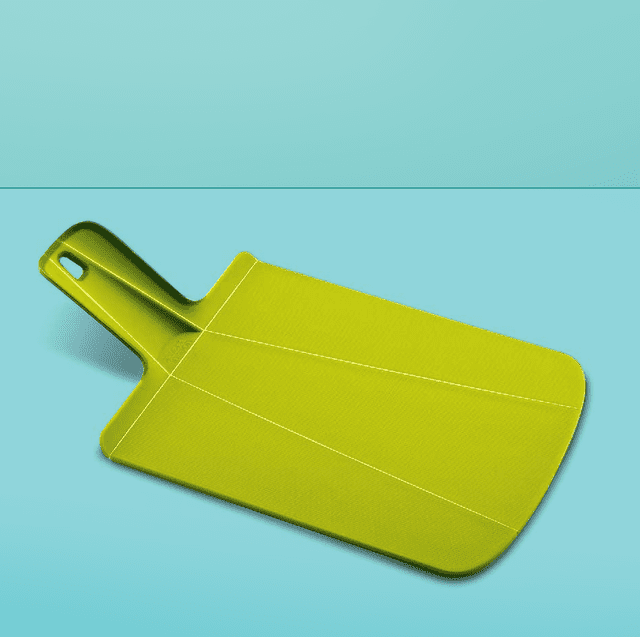
Source: Good Housekeeping
Plastic cutting boards aren’t too strong, so the knives used will create marks and scratches. These marks and scratches allow bacteria, mildew, and other contaminants to thrive.
CAUTION: Plastic cutting boards may contain some chemicals used to make the plastic in their production. These chemicals are harmful to you.
Granite
Granite cutting boards may not be the most common type, but it’s one of the most beautiful. These cutting boards are usually very aesthetically pleasing and very strong. Hence, you can use them for aesthetics and other demanding jobs.
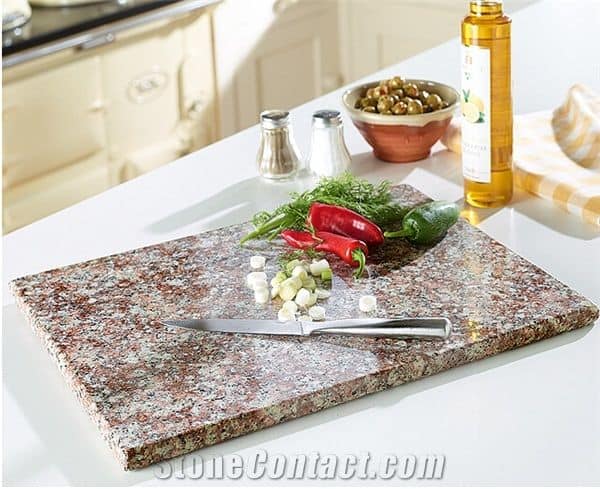
Source: Stonecontact.com
The hardness of these boards can be disadvantageous and dull your knives quickly. The more you cut into the board, the faster your knives require resharpening. These cutting boards are better for rolling and small grinding jobs.
TIP: Granite cutting boards are rare, scarce, and as such, very expensive.
Marble
Marble is another material that you can shape into a cutting board. However, like granite, it is also hard and can damage your knives quickly. Again, it is another expensive option and is better for aesthetic purposes alone.
Glass
Glass is a soft material that breaks easily, so it may not make sense to use it as a base to cut groceries. However, it will surprise you that the glass cutting boards dull your knives like their granite counterparts.

Source: wowcher.co.uk
Tempered glass is the material used to make cutting boards made with glass. This glass is more rigid than the sharp end of your knives and will dull them immediately. So like the granite and marble cutting boards, it’s better to use the glass boards for aesthetics.
Caution: The surface of glass cutting boards can also harbor some bacteria.
Bamboo
Bamboo is a plant that has the features of a tree. It’s another excellent material option for cutting boards, with pros and cons. The main advantage of bamboo is its slow absorption of water.
Most of the items you’ll be putting on your board contain oils and liquids. If you use a wood cutting board, the wood will absorb these liquids quickly. On the other hand, bamboo will take more time to absorb, making it a cleaner option.
Bamboo is also a hard material that can dull your knives very quickly.
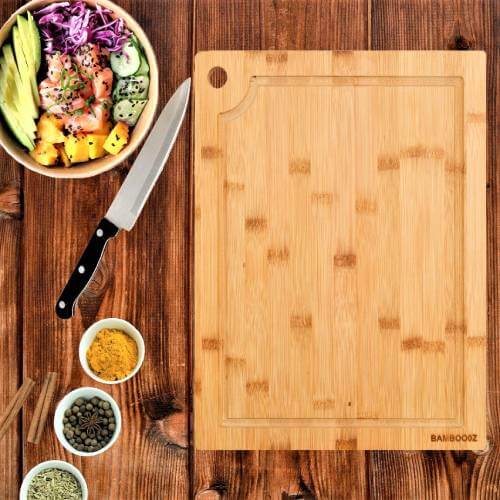
Source: bambooproducts.in
Stoneware
The stoneware cutting board is similar to the granite and marble boards. It’s gorgeous, but it has a hard property. The hardness means it can withstand any force, but it can dull your knives quickly.
Mostly, the stoneware cutting board is best for aesthetics and display purposes.
Related Read: How to Season A Cutting Board?
Silicone
Silicone is another uncommon cutting board material option, but it has many benefits. First, the design of the cutting boards ensures that your knives don’t get dull easily, so it is easier to work with.
Another massive benefit of silicon cutting boards is their anti-slip property. The board tends to hold what you’re cutting firm. Hence, you have more cutting accuracy and prevent accidents.
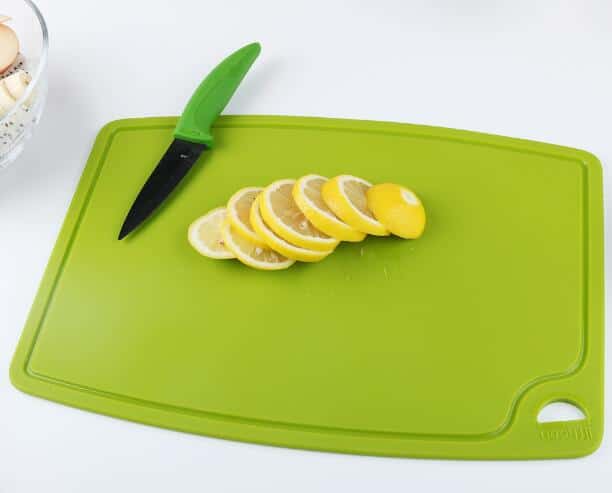
Source: Ecplaza.net
Types of Cutting Board by Grain Pattern
The grain and its pattern are other standard classifications of cutting boards. This class mainly focuses on aesthetics, but it has other perks. Cutting boards under this group are primarily wooden cutting boards.
Let’s take a look at the options
End Grain
The end grain cutting boards may be the most expensive in this category, but their advantages are numerous. The production of these boards follows a process of joining different wood cross-sections together. Hence, you’ll see the rings of the wood from on top instead of the sides.
Usually, the production process of the end grain cutting boards may start with the face or edge grain. The production process is long and confusing, but it earns the end grain cutting boards a good property reputation.
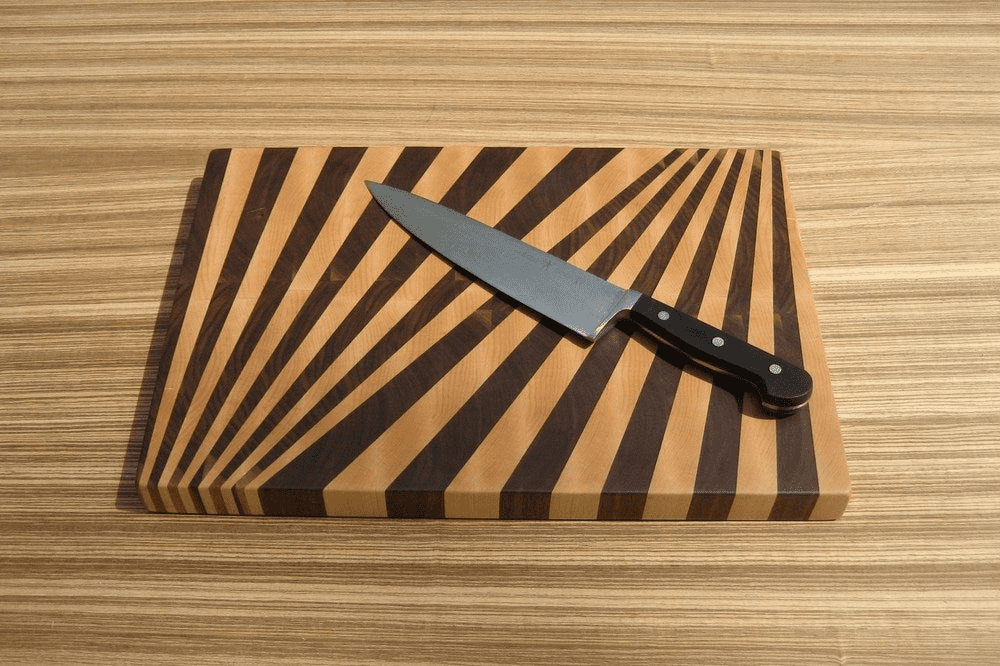
Source: 1337Motif
These boards are usually the strongest under this category. But that strength doesn’t affect the sharpness of your knives, as it’s also gentle.
NOTE: The end grain production process makes it almost impossible for this type of cutting board to warp.
Edge grain
The production process of the edge grain is different from the end grain cutting boards. This time, the grain pattern of these boards forms during the cutting process. As a result, you can see the view of the vertical patterns from the top of the cutting board.
These boards also do a great job against warping and cupping, but not as well as the end grain. A major advantage of these cutting boards is their affordability. These boards are easy to produce in bulk, making them available and usually affordable.
Face grain
Face grain cutting boards are a less common option than wood cutting boards. These boards have a more pronounced grain pattern since it is on the surface. The grain pattern moves in a single direction, making it more prone to warping.
These cutting boards are not the most available, but they are also an amazing choice.
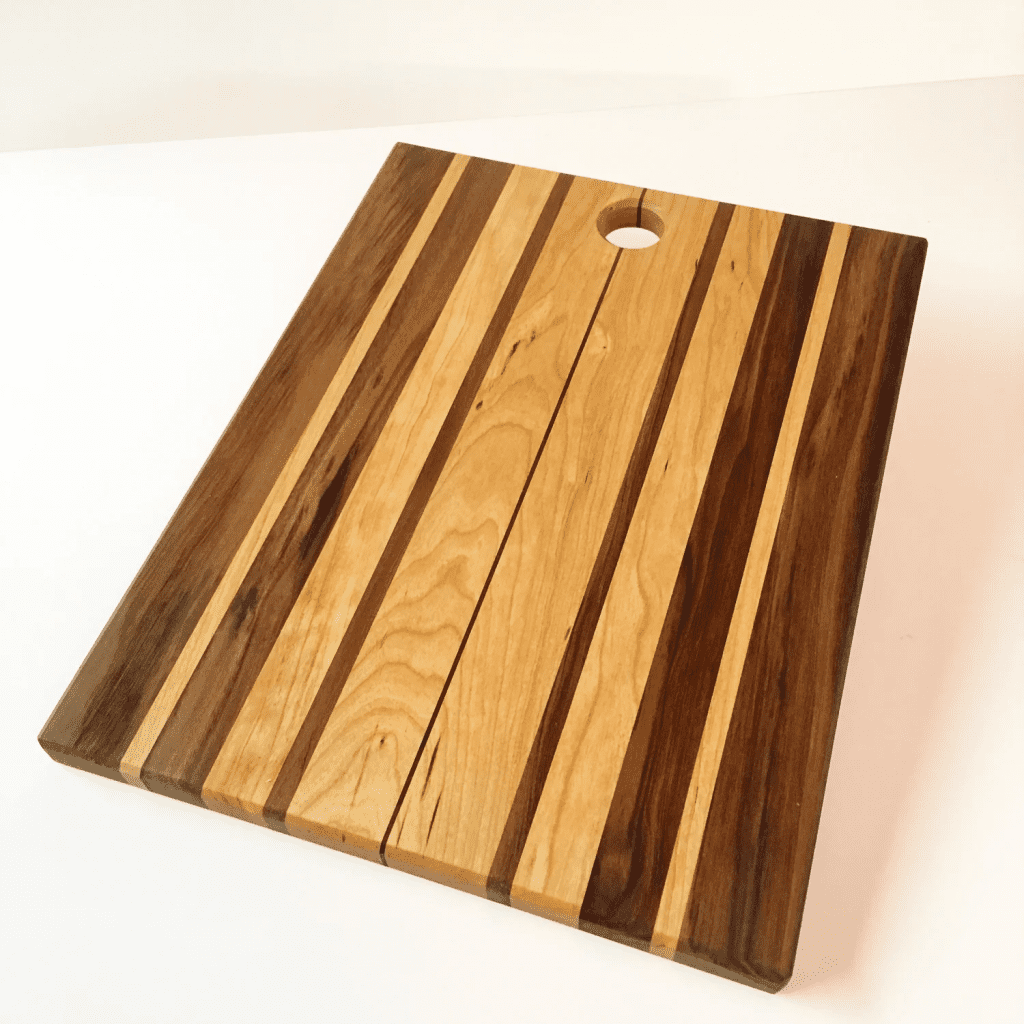
Source: WM Woodworks
Types of Cutting Boards by Color
Another surprising way to classify cutting boards is by their colors. As a homeowner, you don’t need to know all the color codes for cutting boards. Usually, a professional chef or restaurant owner is in the best place to learn these color codes.
The idea of color coding is to determine the function of each one of the cutting boards. These boards are helpful when multiple people are cooking, so you don’t need to ask questions before knowing what each board is for.
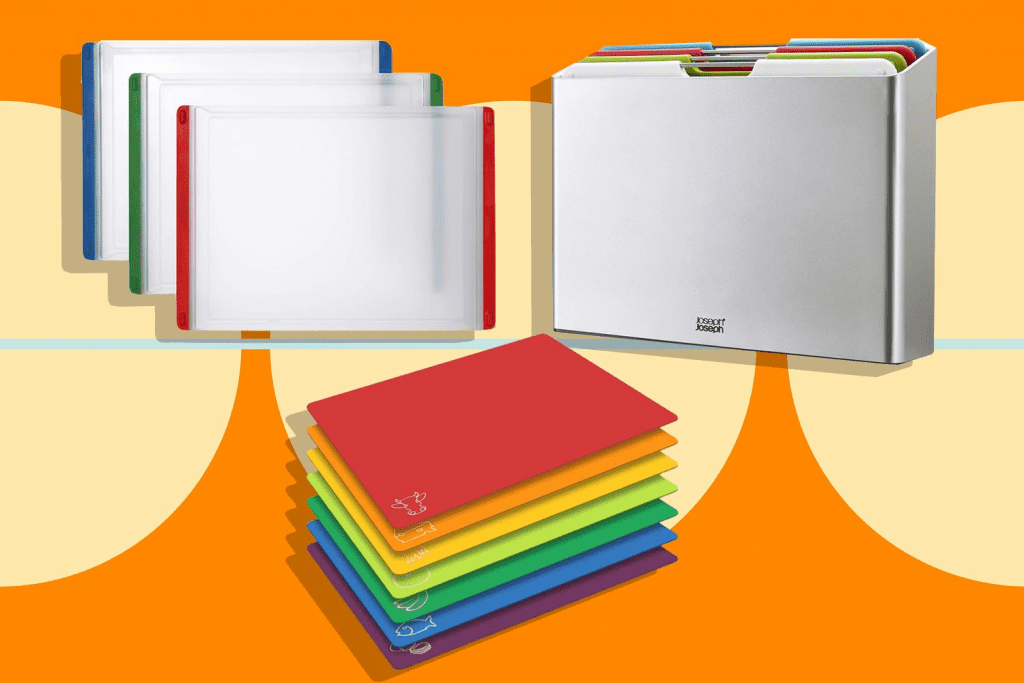
Source: Food and Wine
Blue Chopping Board
The blue chopping board indicates that raw fish is the only item to be cut on the board. This board’s design usually caters to the liquids that secrete when you cut fish.
You can use this board to cut any type of fish, including shellfish, tuna, and all types. Cleaning off this board’s blood, oil, and liquid stains is easy.
CAUTION: Remember to cut raw fish on this board, not cooked fish.
Red chopping board
The red cutting board indicates that you can cut raw meat on it. All types of meat, including cow, goat, poultry, and others, will be cut safely on this board. This board has the design and strength to withstand hard tasks like deboning the meat.
Yellow chopping board
The yellow chopping board also works for meat, but this time, cooked meat and poultry. Some chefs prefer to cut and dice their meat after seasoning it. The yellow chopping board is designed to withstand the oil and seasoning without getting bad.
You can also use the yellow chopping boards to cut cooked fish. Although fish is easy to cut once cooked, the yellow boards are ideal if you need them.
CAUTION: Only use these boards for cutting cooked food.
Brown Chopping Board
The brown chopping board is great for cutting food that still has soil in them. Most of the time, this refers to vegetables and some root foods like a potato. These boards ensure that the sand and debris do not pass into other meals.
White Chopping Board
The white chopping boards work for food materials that contain flour and milk. Examples of these materials include bread, cheese, and other items.
Green Chopping Board
As the name implies, the green cutting board is one for green meals. Examples of these meals include cabbage, fruits, and vegetables. Again, remember to wash the board before use.
Related Read: Acacia Vs. Teak Cutting Board – Here’s What To Buy!
Types of Cutting Boards Based On Shape
The shape of the cutting board is another base for classifying the shape. These shapes make it easy to cut different types and shapes of food. Some of the most common cutting board shapes include the following;
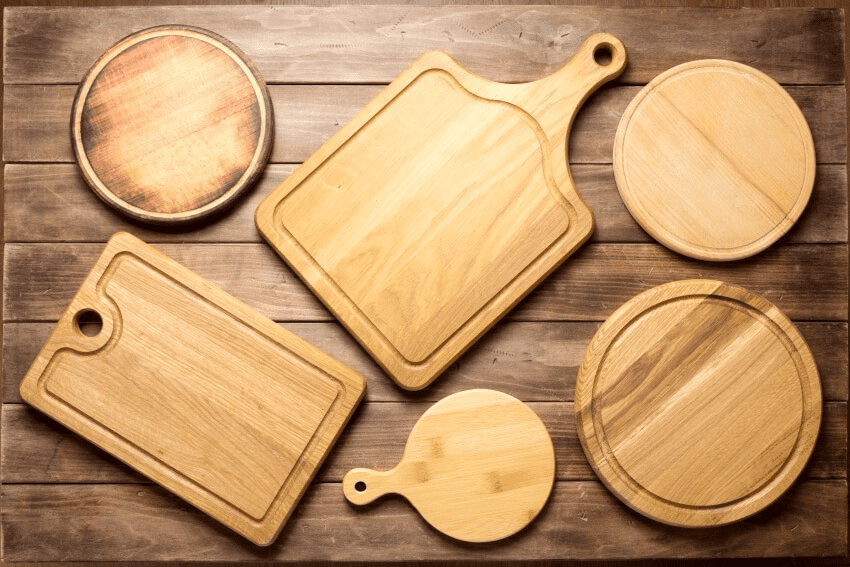
Source: Source: Designing Idea
Circular
The circular or round cutting boards are very attractive and catch anyone’s fancy. However, they are not the most functional cutting boards because they don’t have a lot of space. The only way to buy a circular cutting board that offers you enough space is if you buy the massive ones.
However, most of the time, circular cutting boards are best for displaying food beauty.
Rectangular
Rectangular cutting boards are the most common types you’ll see. It has different sizes and gives you enough space to cut at the edges and all parts of the board.
These boards allow you to push cut meals into a pot, wrap them, and other things.
Semi-circle
The semi-circle cutting boards have a lot of similarities to the round cutting boards. The only advantage it has over round ones is you can push it against the wall to cut food. This makes it more firm.
Square
The square cutting board has a deceitful appearance. It is easy to assume that this board works like a rectangular board. However, this is untrue.
The square cutting board needs more room for cutting, like the rectangular one. The board is also like the circular one, meant for only aesthetic purposes.
Types of Cutting Boards Based on Features and Functions
The final method used to classify cutting boards is their features and functions. The parts may be based on the design of the manufacturers.
TIPS: After the material, you should consider the features and function when choosing a cutting board. This will help guide you to make the right decision.
Anti-slip Cutting Boards
Cutting food items on a cutting board may seem easy until you face a stubborn thing. You’ll need to use a sharper knife or add more force to cut. Whichever one you choose, you can get your hands injured while cutting.
Situations like this are where an anti-slip cutting board is beneficial. This board doesn’t move around while you cut, no matter the force. Hence, you can cut stubborn food items without putting your second hand.
CAUTION: Over time, the anti-slip feature of these cutting boards may reduce, so be careful while you cut.
Reversible Cutting Boards
Reversible cutting boards are boards with both faces that help chop and prep. This type of board is proper if you are still determining the best side to use for cutting.
A significant advantage of this board is it’s more like buying two boards in one. When the first end of the board becomes rough, you can easily switch it to the other side. That way, you will save money on the purchase.
TIPS: Using both sides during the same period will leave your board looking ugly.
Cutting Boards Compatible with Dishwasher
Cooking, cutting, and preparing meals takes time and energy. So it is very likely that you get tired when the food is ready, and washing dishes is hard. In this situation, a cutting board that a dishwasher can wash is beneficial.
All you need to do is to put the cutting board in the device.
Cutting Boards with Knives
The idea of purchasing all your pieces of equipment at once is usually inviting, especially when you are buying new kitchen equipment newly. These types of cutting boards come with knives to cut different types of meals.
Cutting Board Sets
Buying a cutting board set is brilliant if you are a chef. Usually, the cutting board sets come in different colors. This is a great set if you’re not a chef but love a beautiful kitchen.
Handled Cutting Boards
A cutting board with handles may be of great use if you have a large kitchen. These boards allow you to walk around with the cutting boards.
CAUTION: These boards can be dangerous if you don’t use them carefully.
Conclusion: How to Pick The Right Cutting Board
Picking the right cutting board is daunting, given the numerous options. It will be a hard task if you don’t decide what you want or need from your cutting board.
Here are some of the factors to consider when choosing a cutting board;
- The cutting board functions. As a chef, you need multiple cutting boards.
- The durability
- The knife friendliness
- The space
- The cleaning and maintenance method
- Your budget.
![Wood Cutting Board Vs. Plastic Board [Which is Safer?] Wood Cutting Board Vs. Plastic Board [Which is Safer?]](https://houseadorable.com/wp-content/uploads/2023/01/wood-board.jpg)
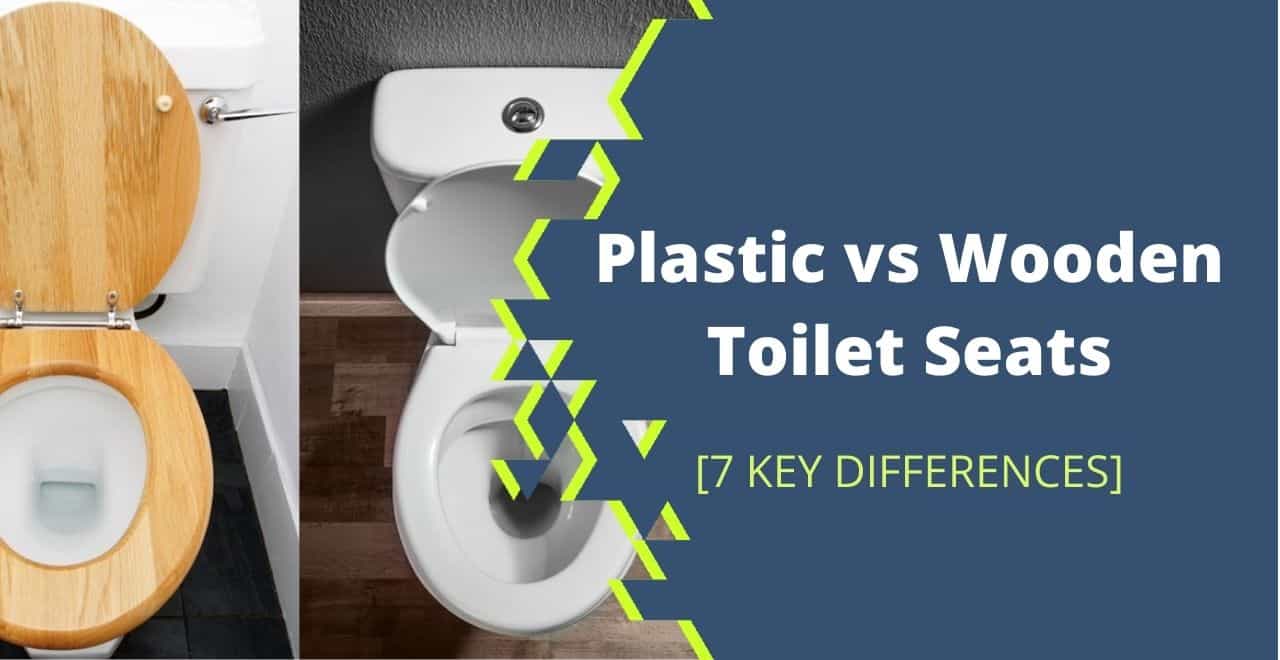
![How to Disinfect Wood Cutting Board? [5 Methods] How to Disinfect Wood Cutting Board? [5 Methods]](https://houseadorable.com/wp-content/uploads/2023/01/1466451602030.jpeg)
![Bamboo Vs. Wood Cutting Board [9 Differences Explained] Bamboo Vs. Wood Cutting Board [9 Differences Explained]](https://houseadorable.com/wp-content/uploads/2023/01/cutting-board.jpg)
![Can You Put A Wooden Cutting Board In The Oven? [Answered] Can You Put A Wooden Cutting Board In The Oven? [Answered]](https://houseadorable.com/wp-content/uploads/2023/01/clean-wooden-cutting-board-4772583_01-2aba9de81be84c55a8e1dbb63822b806-scaled.jpg)
![How to Season A Cutting Board? [Simple Steps Explained] How to Season A Cutting Board? [Simple Steps Explained]](https://houseadorable.com/wp-content/uploads/2022/12/cutting.jpeg)
![Is Acacia Wood Good For Cutting Boards? [Explained] Is Acacia Wood Good For Cutting Boards? [Explained]](https://houseadorable.com/wp-content/uploads/2023/01/wood-table-top-with-acacia-chopping-board-with-blur-kitchen-counter-background-is.jpg)
![Can You Put Wood Cutting Board In Dishwasher? [Explained] Can You Put Wood Cutting Board In Dishwasher? [Explained]](https://houseadorable.com/wp-content/uploads/2022/12/dish.jpg)